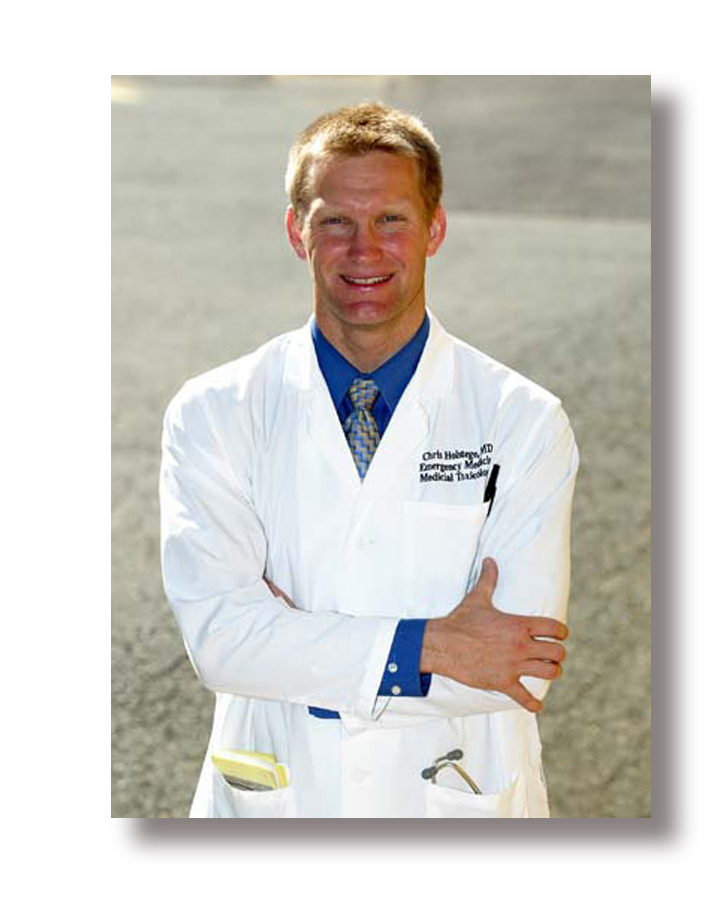Listen to the UVA Today Radio Show report on this story by Marian Anderfuren:
April 26, 2010 — Criminal poisoning cases can be hard to recognize and even harder to solve when law enforcement officials lack a combination of clinical and forensic perspectives on what a poisoning looks like.
For example, cyanide poisoning is not easily diagnosed, according to Dr. Christopher Holstege, director of the Division of Toxicology at the University of Virginia Health System and co-author of a new book, "Criminal Poisoning: Clinical and Forensic Perspectives." Holstege knows this because he has seen cyanide poisoning in his clinical practice and has been called to testify in court on cyanide's clinical effects.
"Reputed experts have testified that a smell of 'bitter almonds' is always present on the victim of cyanide poisoning, but this is not supported by the literature," Holstege said. "A physician examining a patient poisoned by cyanide may smell nothing out of the ordinary."
In this example, the lack of a correct clinical perspective could lead investigative teams down a wrong path when trying to convict a criminal who has poisoned. "Criminal Poisoning" contains information for law enforcement, attorneys and medical providers to use when investigating cases of suspected criminal poisonings. With a foreword from John Alderdice, consultant psychiatrist and member of the British House of Lords, and former U.S. Attorney General Edwin Meese III, the book was written with a high level of international expertise.
"Access to poisonous agents and knowledge on how to use them are easily available to criminals," Holstege said. "This new book gives medical personnel and law enforcement information about potential agents that could be used to commit a poisoning as well as the profiles of criminals who poison, based on actual historic cases."
Some of the agents discussed in the book have been seen frequently in past criminal poisonings. Others discussed, such as the rarely used dioxin, appeared in prominent poisoning cases.
Over the last two decades, criminal poisonings have been on the rise, though current numbers don't always include survivors. A criminal poisoning is any deliberate attempt to inflict harm on others through the use of toxins. Criminals who poison can work alone or in groups. Incidents can range from an individual criminal slipping a date rape drug into someone's drink to terrorists unleashing a deadly chemical agent in a subway station full of people.
"Criminal Poisoning" was co-authored by Dr. Gregory B. Saathoff, associate professor of research and executive director of the Critical Incident Analysis Group at U.Va.'s School of Medicine.
The book was edited by Thomas Neer, supervisory special agent for the FBI Academy in the Critical Incident Response Group-Behavioral Analysis Unit in Quantico, and Dr. R. Brent Furbee, medical director of the Indiana Poison Center at Methodist Hospital in Indianapolis.
April 26, 2010 — Criminal poisoning cases can be hard to recognize and even harder to solve when law enforcement officials lack a combination of clinical and forensic perspectives on what a poisoning looks like.
For example, cyanide poisoning is not easily diagnosed, according to Dr. Christopher Holstege, director of the Division of Toxicology at the University of Virginia Health System and co-author of a new book, "Criminal Poisoning: Clinical and Forensic Perspectives." Holstege knows this because he has seen cyanide poisoning in his clinical practice and has been called to testify in court on cyanide's clinical effects.
"Reputed experts have testified that a smell of 'bitter almonds' is always present on the victim of cyanide poisoning, but this is not supported by the literature," Holstege said. "A physician examining a patient poisoned by cyanide may smell nothing out of the ordinary."
In this example, the lack of a correct clinical perspective could lead investigative teams down a wrong path when trying to convict a criminal who has poisoned. "Criminal Poisoning" contains information for law enforcement, attorneys and medical providers to use when investigating cases of suspected criminal poisonings. With a foreword from John Alderdice, consultant psychiatrist and member of the British House of Lords, and former U.S. Attorney General Edwin Meese III, the book was written with a high level of international expertise.
"Access to poisonous agents and knowledge on how to use them are easily available to criminals," Holstege said. "This new book gives medical personnel and law enforcement information about potential agents that could be used to commit a poisoning as well as the profiles of criminals who poison, based on actual historic cases."
Some of the agents discussed in the book have been seen frequently in past criminal poisonings. Others discussed, such as the rarely used dioxin, appeared in prominent poisoning cases.
Over the last two decades, criminal poisonings have been on the rise, though current numbers don't always include survivors. A criminal poisoning is any deliberate attempt to inflict harm on others through the use of toxins. Criminals who poison can work alone or in groups. Incidents can range from an individual criminal slipping a date rape drug into someone's drink to terrorists unleashing a deadly chemical agent in a subway station full of people.
"Criminal Poisoning" was co-authored by Dr. Gregory B. Saathoff, associate professor of research and executive director of the Critical Incident Analysis Group at U.Va.'s School of Medicine.
The book was edited by Thomas Neer, supervisory special agent for the FBI Academy in the Critical Incident Response Group-Behavioral Analysis Unit in Quantico, and Dr. R. Brent Furbee, medical director of the Indiana Poison Center at Methodist Hospital in Indianapolis.
Media Contact
Article Information
April 26, 2010
/content/uva-toxicologist-offers-law-enforcement-glimpse-medical-realm-criminal-poisonings

